Potato
Solanum tuberosum L.
Solanaceae
Varieties
Kufri Jyoti, Kufri Muthu, Kufri Swarna, Kufri Thangam, Kufri Malar, Kufri Soga and Kufri Giriraj are commonly cultivated.
Soil
The soil should be friable, porous and well drained. The optimum soil pH range is 4.8 to 5.4. It prefers a cool weather. Potato is mostly grown as a rainfed crop in regions receiving a rainfall of 1200 – 2000 mm per annum.
Season
Hills
Summer : March – April
Autumn : August – September
Irrigated : January – February
Plains
Planting is done during October – November in plains.
Seed rate
About 3000 – 3500 kg/ha of seeds is required.
Seed treatment
Use Carbon disulphide 30 g/100 kg of seeds for breaking the dormancy and inducing sprouting of tubers.
True potato seed
The cost of seed tubers and spread of virus disease can be greatly minimized by using ‘true potato seeds’. The hybrids developed by Central Potato Research Institute viz., HPS 1/13, HPS 11/13 and HPS 24/111 are suitable for true potato seed production. The seeds are raised in nursery beds like other vegetables and seedlings are transplanted 30 days after sowing. For raising one hectare of crop, a quantity of 100 g seed is required.
Preparation of field
Prepare the land to fine tilth. In hills provide an inward slope in the terraces. Provide drainage channel along the inner edge of the terrace. Form ridges and furrows with a spacing of 45 cm between ridges either by hand hoe or ridger.
Planting
Use disease free, well spouted tubers weighing 40 – 50 grams for planting. Plant the tubers at 20 cm apart.
Irrigation
Irrigate the crop 10 days after planting. Subsequent irrigation should be given once in a week.
Application of fertilizers
Apply 15 t/ha of FYM and 2 kg each of Azospirillum and Phosphobacterium as basal and 120 kg N, 240 kg P and 120 kg K/ha in two splits; half as basal and the balance for top dressing on 30 days after sowing. Apply Magnesium sulphate at 60 kg/ha as basal dose.
After cultivation
Weed control
The critical period of weed-competition is upto 60 days and it is essential to keep the field weed-free during that period. Take up the first hoeing on 45th day without disturbing stolons. Second hoeing and earthing can be taken up at 60th day.
Plant protection
Pests
Nematodes
Avoid growing potato year after year in the same field. Follow rotation with vegetables and green manure. Application of Carbofuran 3 G (1.0 kg a.i.) 33 kg/ha in furrows while seeding. For cyst nematode resistant variety Kufri Swarna, half dose of the above nematicide is enough.
Biological control of nematodes
Application of Pseudomonas fluorescens at 10 kg/ha will control the nematode population.
Aphids
Aphids can be controlled by spraying Methyl demeton 25 EC or Dimethoate 30 EC 2 ml/lit.
Cut worms
- Install light trap during summer to attract adult moths.
- Install sprinkler irrigation system and irrigate the field in day time to expose the larvae for predation by birds.
- Drench the collar region of the plants in evening hours with Chlorpyriphos or Quinalphos 2 ml/lit a day after planting.
White grub
- Summer ploughing to expose the pupae and adults.
- Dust Quinalphos 5 D at 25 kg/ha 10 days after first summer rains.
- Install light traps between 7 p.m. and 9 p.m. in April - May months.
- Hand pick the adult beetles in the morning.
- Hand pick the 3rd instar grub during July - August.
- In endemic areas apply Phorate 10 G at 25 kg/ha during autumn season (August - October).
Potato tuber moth
- Avoid shallow planting of tubers. Plant the tubers to a depth at 10 - 15 cm deep.
- Install pheromone traps at 20 No/ha.
- Earth up at 60 days after planting to avoid potato tuber moth egg laying in the exposed tubers.
- To control foliar damage spray NSKE 5 % or Quinalphos 20 EC 2 ml/lit (ETL 5 % leaf damage).
- Keep pheromone traps in godowns.
- In godowns cover the upper surface of potato leaves with Lantana or Eupatorium branches to repel ovipositing moths.
- Treat the seed tubers with Quinalphos dust @ 1 kg/100 kg of tubers.
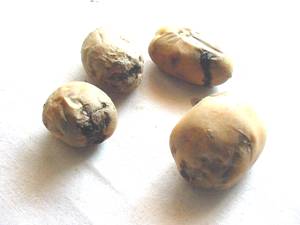
Potato tuber moth
Diseases
Late blight
Remove ground creepers which serve as a source of infection. Spray Mancozeb 2 g/lit or Chlorothalonil 2 g/lit on 45, 60 and 75 days after planting. Grow late blight resistant varieties like Kufri Jyothi, Kufri Malar and Kufri Thangam.
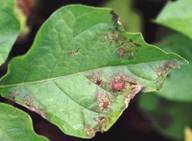 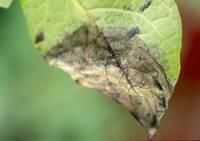 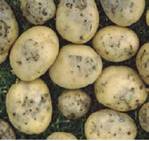
Late blight
Brown rot
Select brown rot disease free tubers. Give proper drainage facilities. Remove and destroy the affected plants.
Early blight
Early blight can be controlled by spraying Mancozeb 2 g/lit or Chlorothalonil 2 g/lit at 45, 60 and 75 days after planting.
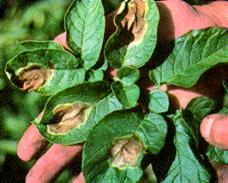 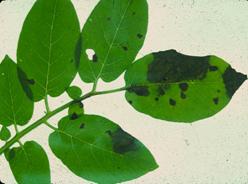
Early blight
Virus diseases
Use virus free potato seeds. Rogue the virus affected plants regularly. Control the aphid vectors by spraying Dimethoate or Methyl demeton 2 ml/ha.
Yield
15 – 20 t/ha of tubers can be obtained.
Source
1. http://www.ctahr.hawaii.edu/nelsons/Misc/1_potato_late_blight_1.jpg
2. http://upload.wikimedia.org/wikipedia/commons/a/a6/Symptom_potato_late_blight.jpg
3. http://www.manage.gov.in/atmakangra/images/potatos1.jpg
4. http://plant-disease.ippc. orst.edu/plant_ images/Potato_ Early_Blight_&_ Late_Blight. jpg
5. http://www.ag.ndsu.edu/pubs/plantsci/hortcrop/pp1084-1.gif
Updated on : 26.08.2013 |






